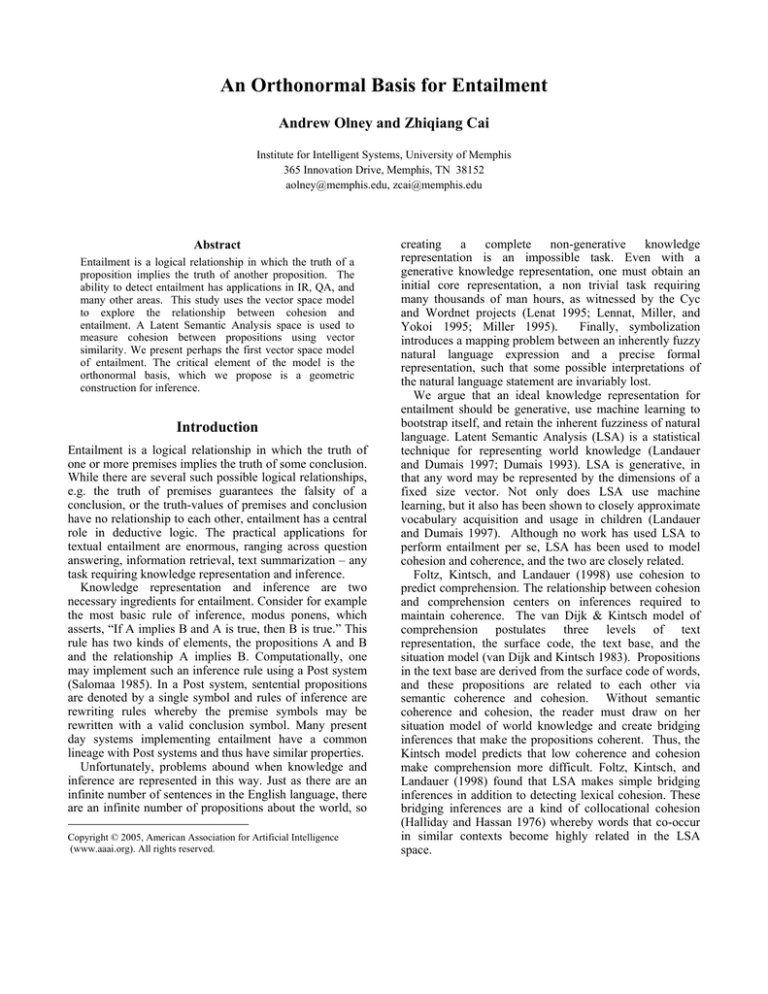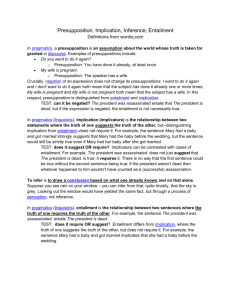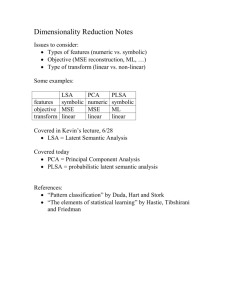
An Orthonormal Basis for Entailment
Andrew Olney and Zhiqiang Cai
Institute for Intelligent Systems, University of Memphis
365 Innovation Drive, Memphis, TN 38152
aolney@memphis.edu, zcai@memphis.edu
Abstract
Entailment is a logical relationship in which the truth of a
proposition implies the truth of another proposition. The
ability to detect entailment has applications in IR, QA, and
many other areas. This study uses the vector space model
to explore the relationship between cohesion and
entailment. A Latent Semantic Analysis space is used to
measure cohesion between propositions using vector
similarity. We present perhaps the first vector space model
of entailment. The critical element of the model is the
orthonormal basis, which we propose is a geometric
construction for inference.
Introduction
Entailment is a logical relationship in which the truth of
one or more premises implies the truth of some conclusion.
While there are several such possible logical relationships,
e.g. the truth of premises guarantees the falsity of a
conclusion, or the truth-values of premises and conclusion
have no relationship to each other, entailment has a central
role in deductive logic. The practical applications for
textual entailment are enormous, ranging across question
answering, information retrieval, text summarization – any
task requiring knowledge representation and inference.
Knowledge representation and inference are two
necessary ingredients for entailment. Consider for example
the most basic rule of inference, modus ponens, which
asserts, “If A implies B and A is true, then B is true.” This
rule has two kinds of elements, the propositions A and B
and the relationship A implies B. Computationally, one
may implement such an inference rule using a Post system
(Salomaa 1985). In a Post system, sentential propositions
are denoted by a single symbol and rules of inference are
rewriting rules whereby the premise symbols may be
rewritten with a valid conclusion symbol. Many present
day systems implementing entailment have a common
lineage with Post systems and thus have similar properties.
Unfortunately, problems abound when knowledge and
inference are represented in this way. Just as there are an
infinite number of sentences in the English language, there
are an infinite number of propositions about the world, so
Copyright © 2005, American Association for Artificial Intelligence
(www.aaai.org). All rights reserved.
creating
a
complete
non-generative
knowledge
representation is an impossible task. Even with a
generative knowledge representation, one must obtain an
initial core representation, a non trivial task requiring
many thousands of man hours, as witnessed by the Cyc
and Wordnet projects (Lenat 1995; Lennat, Miller, and
Yokoi 1995; Miller 1995).
Finally, symbolization
introduces a mapping problem between an inherently fuzzy
natural language expression and a precise formal
representation, such that some possible interpretations of
the natural language statement are invariably lost.
We argue that an ideal knowledge representation for
entailment should be generative, use machine learning to
bootstrap itself, and retain the inherent fuzziness of natural
language. Latent Semantic Analysis (LSA) is a statistical
technique for representing world knowledge (Landauer
and Dumais 1997; Dumais 1993). LSA is generative, in
that any word may be represented by the dimensions of a
fixed size vector. Not only does LSA use machine
learning, but it also has been shown to closely approximate
vocabulary acquisition and usage in children (Landauer
and Dumais 1997). Although no work has used LSA to
perform entailment per se, LSA has been used to model
cohesion and coherence, and the two are closely related.
Foltz, Kintsch, and Landauer (1998) use cohesion to
predict comprehension. The relationship between cohesion
and comprehension centers on inferences required to
maintain coherence. The van Dijk & Kintsch model of
comprehension postulates three levels of text
representation, the surface code, the text base, and the
situation model (van Dijk and Kintsch 1983). Propositions
in the text base are derived from the surface code of words,
and these propositions are related to each other via
semantic coherence and cohesion. Without semantic
coherence and cohesion, the reader must draw on her
situation model of world knowledge and create bridging
inferences that make the propositions coherent. Thus, the
Kintsch model predicts that low coherence and cohesion
make comprehension more difficult. Foltz, Kintsch, and
Landauer (1998) found that LSA makes simple bridging
inferences in addition to detecting lexical cohesion. These
bridging inferences are a kind of collocational cohesion
(Halliday and Hassan 1976) whereby words that co-occur
in similar contexts become highly related in the LSA
space.
The present study builds upon the idea that LSA has
some inferential properties and explores the relationship
between cohesion and entailment. Towards this end a LSA
space representing general world knowledge was created
to measure cohesion and other vector metrics between
entailment pairs. Orthonormal bases of LSA vectors are
introduced as an important source of metrics for
entailment. The study suggests that orthonormal bases are
a sufficient condition for entailment using a vector space
model.
Section 1 introduces LSA as a vector space model,
Section 2 summarizes the use of orthonormal bases with
LSA and their relationship to inferencing, Section 3
presents the method used in this study, Section 4 presents
the results, Section 5 is the discussion, and Section 6
concludes.
The Vector Space Model
The vector space model is a statistical technique that
represents the similarity between collections of words as a
cosine between vectors (Manning and Schutze 2002). The
process begins by collecting text into a corpus. A matrix is
created from the corpus, having one row for each unique
word in the corpus and one column for each document or
paragraph. The cells of the matrix consist of a simple
count of the number of times word i appeared in document
j. Since many words do not appear in any given document,
the matrix is often sparse. Weightings are applied to the
cells that take into account the frequency of word i in
document j and the frequency of word i across all
documents, such that distinctive words that appear
infrequently are given the most weight. Two collections of
words of arbitrary size are compared by creating two
vectors. Each word is associated with a row vector in the
matrix, and the vector of a collection is simply the sum of
all the row vectors of words in that collection. Vectors are
compared geometrically by the cosine of the angle between
them.
LSA (Landauer and Dumais 1997; Dumais 1993) is an
extension of the vector space model that uses singular
value decomposition (SVD). SVD is a technique that
creates an approximation of the original word by document
matrix. After SVD, the original matrix is equal to the
product of three matrices, word by singular value, singular
value by singular value, and singular value by document.
The size of each singular value corresponds to the amount
of variance captured by a particular dimension of the
matrix. Because the singular values are ordered in
decreasing size, it is possible to remove the smaller
dimensions and still account for most of the variance. The
approximation to the original matrix is optimal, in the least
squares sense, for any number of dimensions one would
choose. In addition, the removal of smaller dimensions
introduces linear dependencies between words that are
distinct only in dimensions that account for the least
variance. Consequently, two words that were distant in the
original space can be near in the compressed space,
causing the inductive machine learning and knowledge
acquisition effects reported in the literature (Landauer and
Dumais 1997).
An Orthonormal Basis
Cohesion can be measured by comparing the cosines of
two successive sentences or paragraphs (Foltz, Kintsch,
and Landauer 1998). However, cohesion is a crude
measure: repetitions of a single sentence will be highly
cohesive (cosine of 1) but inadequate since no new
information is introduced. A variation of the LSA
algorithm using orthonormalized vectors provides two new
measures, informativity and relevance, which can detect
how much new information is added and how relevant it is
in a context (Hu et al. 2003). The essential idea is to
represent context by an orthonormalized basis of vectors,
one vector for each utterance. The basis is a subspace of
the higher dimensional LSA space, in the same way as a
plane or line is a subspace of 3D space. The basis is
created by projecting each utterance onto the basis of
previous utterances using a method known as the GramSchmidt process (Anton 2000). Since each vector in the
span is orthogonal, the basis represents all linear
combinations of what has been previously said. For
example, in Figure 1, a new utterance creates a new vector
that can be projected to the basis, forming a triangle. The
leg of the triangle that lies along the basis indicates the
relevance of the recent utterance to the basis; the
perpendicular leg indicates new information. Accordingly,
a repeated utterance would have complete relevance but
zero new information.
Informativity
VS 1
VS 2
Relevance
Figure 1. Projecting a new utterance to the basis
Similarly to van Dijk & Kintsch's model of comprehension
(van Dijk and Kintsch 1983), dialogue can require
inference to maintain coherence. According to Grice's Cooperative Principle, utterances lacking semantic coherence
flout the Maxim of Relevance and license an inference
(Grice 1975):
S1: Do you want to go out dancing tonight?
S2: I have an exam tomorrow.
The "inference" in the sense of Foltz, Kintsch, and
Landauer (1998) is modeled by a fair cosine between these
utterances, even though they don't share any of the same
words (i.e. the inductive property of LSA). Since the
addition of vectors can arbitrarily change the cosine, such
inferences can be lost with the addition of more words to a
text unit. Using a span, each utterance is kept independent,
so inferencing can extend over both the entire set of
utterances and the linear combination of any of its subsets.
Accordingly, when heavy inferencing is required, one
would expect a span-based method to be better able to
model semantic coherence and cohesion than a standard
vector-based method.
Method
In this section we present the method used in this study.
Our first concern was to find a data set for training and
testing. A data set has been recently made available via
the PASCAL Textual Entailment Challenge, a program
which seeks to provide a common data set for comparing
applications that perform semantic inference (PASCAL
2004). Below are two example propositions and their
corresponding true and false hypothesis:
Eyeing the huge market potential, currently led by
Google, Yahoo took over search company Overture
Services Inc last year.
Yahoo bought Overture.
Microsoft's rival Sun Microsystems Inc. bought Star
Office last month and plans to boost its development
as a Web-based device running over the Net on
personal computers and Internet appliances.
Microsoft bought Star Office.
We collected all proposition-hypothesis pairs from the
public data sets and randomly assigned these to training
and testing conditions. After assignment there were 259
pairs in the training set and 308 pairs in the testing set.
Amongst all these pairs, approximately half are true
entailments and the other half false entailments. None of
these pairs were used in the creation of the LSA space, as
that could potentially contaminate the results.
The LSA space was created using the Touchstone
Applied Science Associates (TASA) corpus used for The
Educator's Word Frequency Guide (TASA 2004). TASA
constructed the corpus using a “degrees of reading power”
scale (DRP) that scores the difficulty of text encountered
by students at grades 3, 6, 9, 12, and college. The TASA
corpus contains example texts at each of these levels, but
more importantly, the DRP scale suggests that the text for
a 9th grade student also contain the text for the lower
levels. Thus the TASA corpus represents a developmental
trajectory in world knowledge, as opposed to WordNet
glosses (Miller, 1995) or other textual knowledge
representations like the MIT OpenMind CommonSense
project (Singh et al., 2002). It is hypothesized in the
current study that a developmental corpus will allow better
bootstrapping of world knowledge than a nondevelopmental corpus, an assumption that requires more
research.
The present study used the 12th grade version of the
TASA corpus. The corpus contains 28,882 documents and
76,132 terms. The corpus was made lower case, and split
into paragraphs for LSA. The following example
paragraph is typical of this corpus:
a circle of seasons
; livingston, myra cohn ;
holiday house ; 1982 26pp. isbn: 0-8234-0452-8 ;
drp mean: n/a ; a cycle of poems about the four
seasons, illustrated with paintings by leonard everett
fisher.
No other processing was performed, e.g. tagging.
However, the LSA space was made without counting the
standard set of common words, as these are generally
thought to only add noise. The space was made with 300
dimensions using log entropy weighting.
Training consisted of calculating various vector space
metrics on the proposition-hypothesis pairs and using
logistic regression to fit a classifier to the data. Of
particular interest are the standard geometric cosine and
two new metrics associated with the orthonormal basis.
These two metrics are based on the following procedure.
First, for each word in the proposition, the associated
vector was projected onto the basis, and the component of
the vector perpendicular to the basis was normalized and
added to the basis. Secondly, the vector representation of
the hypothesis was projected into the basis, yielding two
elements, a perpendicular component and a parallel
component. Given these two elements, the most sensible
theoretical metrics are the perpendicular length and cosine
between the hypothesis and the parallel component. These
reflect the weight of new information in the hypothesis and
the similarity of the hypothesis, respectively. These
metrics are logical from the standpoint that we expect a
hypothesis to be similar to the proposition but at the same
time add a little bit of new information. Parameters for
these metrics were fitted to a linear model using binary
logistic regression, and these models were tested for
statistical significance.
Finally, the regression model created in training was
evaluated against the unseen testing data. The outcomes of
training and testing are reviewed in the next section.
Results
In training we focused on both cosine and the two basis
metrics given above. Using a χ2 test for significance, we
found that the regression model using cosine is not a
significant predictor of entailment at p < .05. However,
the regression model using both basis metrics is a
significant predictor of entailment at p < .05. The error
confusion matrix for training is given below:
Predicted
True
False
Observed
True
95
40
False
73
51
Table 1. Error confusion matrix for training
While precision, recall, and F-measure (Manning and
Schutze) could be calculated for this error-confusion
matrix, these measures are misleading in this context.
Consider that a model which always predicts TRUE will
have an F-measure of .67 out of 1.0, because the TRUE
and FALSE cases have even odds. In this situation, dprime and the associated measures of hit rate and false
alarm rate are more informative (Swets, Tanner, and
Birdsall 1961). For the regression model using the
orthonormal basis, these are .70, .59, and .31 respectively.
With respect to a baseline of chance, the d-prime indicates
that there are .31 normal standard deviates between the
mean of the non-entailment distribution and the mean of
the entailment distribution. The Receiver Operating
Characteristic Curve in Figure 2 illustrates the relationship
between hit rate and false alarm rate in the model.
e −.275−1.429* perpendicularLength +.667* parallelCo sin e
1 + e −.275−1.429* perpendicularLength +.667* parallelCo sin e
The parameters of this equation are a constant term, -.275
and two coefficients for the basis metrics, -1.429 and .667.
The sign of these last two coefficients illuminates their role
in the model. The negative sign on the coefficient for
perpendicular length indicates that perpendicular length is
inversely correlated with a hypothesis being a valid
entailment. Therefore too much new information in a
hypothesis contraindicates a valid entailment. On the other
hand, the positive sign on the parallel cosine indicates that
a hypothesis should have elements in common with its
proposition. Beyond the sign, the exponentials of these
values indicate how the two basis metrics are weighted.
For example, when perpendicular length is raised by one
unit, a FALSE entailment is .24 more times likely. When
parallel cosine is raised by one unit, a TRUE entailment is
1.95 more times likely.
Running the trained model over the testing data showed
that the correct classification was significant, p < .05,
using a χ2 test for significance. Performance was
surprisingly consistent across both training and testing.
The testing hit rate, false alarm rate, and d-prime are .72,
.60, and .30, compared to the training values of .70, .59,
and .31.
This is strong evidence that the model has
generalized well to the underlying pattern in the data. The
error confusion matrix for the test data is given in Table 2.
Predicted
True
False
Observed
True
106
42
False
97
63
Table 2. Error confusion matrix for testing
Discussion
Figure 2. Receiver Operating Characteristic Curve
Binomial logistic regression produced a model which
predicts TRUE when the following value is greater than .5:
Our intuition that the basis method is performing a kind of
inference is strongly supported by these results. In the
general case for this data set, inference is required to
determine whether an entailment relation exists. For if
simple substitution were enough, the cosine metric would
be a significant predictor of entailment, and we have found
that cosine is not a significant predictor. Thus we have
shown, perhaps for the first time, that it is possible to use a
vector space model by itself to detect entailments.
Moreover, we have shown that using the basis method, a
general knowledge source like TASA can be generative
enough to make inferences over foreign material.
Not only do the results demonstrate that inference is
required to solve this problem, but also the manner in
which inference is supplied is consistent with the
geometric intuition behind the basis model. Recall that
since a basis is a subspace of a vector space, an infinite
number of statements can be represented inside the basis.
The propositions generated by the basis are a clear
analogue to implicatures generated by inference.
According to intuition, an entailment should be largely
contained within the subspace generated by the basis;
otherwise it would not be inferable. Likewise in our basis
model, the greater the cosine between the basis and the
hypothesis vector, the more likely the hypothesis is to be
an entailment (1.95 more times likely for every unit
increase of cosine). Symmetrically, the greater the weight
of information outside the basis, as represented by the
length of the hypothesis component perpendicular to the
basis, the less likely the hypothesis is to be an entailment
(.24 times less likely for every unit increase in
perpendicular length).
Equal training and testing performance suggests that the
model is generalizing well with respect to what it can
represent. The basis is a intuitive model for inference, and
it is possible that low performance speaks more to the
kinds of information that are currently missing from the
vector space model than from an inherent weakness in the
basis method. The orthonormal basis method does quite
well, especially considering that it stands on the shoulders
of LSA, which only makes use of collocational
information in the corpus.
Entailment is a notoriously difficult problem, and there
are a number of factors working against the current
method. One is that the training and testing set contain
many terms that are not found in the LSA space. This is
because these data sets are drawn largely from current
events and contain many proper nouns, e.g. “Aristide” that
are not likely to be found in TASA. In addition, the
entailment data set makes use of mathematical notation,
relying on a system’s ability to reason over quantity. This
is not possible with LSA – a mathematical expression or
quantity is simply substitutable for another quantity or
word. The substitutability issue comes up also with
antonyms, synonyms, and hyper/hyponyms, all of which
LSA treats the same (Foltz, Kintsch, and Landauer 1998).
Consider the following entailment pair taken from the data
set:
Crude oil for April delivery traded at $37.80 a barrel,
down 28 cents
Crude oil prices rose to $37.80 per barrel
Clearly “down” and “rose” have an antonym flavor to their
relationship, but the LSA cosine between these two words
is high because they are substitutable in the same contexts.
Finally, word order is a problem in LSA. Because addition
is commutative, i.e. 1+2 = 2+1, word order is lost when
word vectors are added to create document vectors.
Therefore “John likes Mary” and “Mary likes John”, which
do not have an entailment relationship between them,
would have a cosine of 1. All of these factors are
challenges for future research.
It is important to recognize that the method outlined in
this paper specifically addresses the verification of
inferences rather than their generation. However, within
the given framework, it is possible to view the orthonormal
basis as an approximation of all of the valid inferences
obtainable from a statement. Clearly this approximation
over-generates, because it pays no attention to word order,
negation, or the other phenomena listed above. While this
perspective is consistent with the current approach, the
present study cannot confirm it.
Conclusion
The vector space model uses machine learning, is
generative, and maintains the fuzziness of natural
language. As such, the vector space model is a natural
candidate to consider for knowledge representation. This
study has shown that one can capitalize on vector space
structure to create the capability for inference and
entailment. The orthonormal basis method is a clean
extension to the vector space model with a clear analogue
to inference: the basis represents all linear combinations of
the words in the hypothesis and as such should largely
contain the hypothesis. This study is perhaps the first to
demonstrate entailment using the vector space model. New
enhancements and extensions await discovery.
Acknowledgements
This research on was supported by the National Science
Foundation (SBR 9720314 and REC 0106965) and the
Department of Defense Multidisciplinary University
Research Initiative administered by the Office of Naval
Research (N00014-00-1-0600). Any opinions, findings,
and conclusions or recommendations expressed in this
material are those of the authors and do not necessarily
reflect the views of DoD, ONR, or NSF.
References
Anton, H. 2000. Elementary linear algebra. 8th edition.
New York: John Wiley.
van Dijk, T. A., and Kintsch, W. 1983. Strategies of
Discourse Comprehension. New York: Academic Press.
Dumais, S. 1993. LSI Meets TREC: A Status Report. In
Proceedings of the First Text Retrieval Conference
(TREC1), 137-152. NIST Special Publication 500-207.
Foltz, P.W.; Kintsch, W.; and Landauer, TK. 1998. The
measurement of textual Cohesion with Latent Semantic
Analysis. Discourse Processes, 25: 285-307.
Garson, D. Logistic Regression. Accessed on April 18th,
2003. http://www2.chass.ncsu.edu/garson/pa765/logistic
Grice, H.P. 1975. Logic and conversation. In Cole, P. and
Morgan, J. (eds) Syntax and Semantics 3: 41-58. New
York: Academic.
Halliday, M. A. and Hassan, R. A.. 1976. Cohesion in
English. London: Longman.
Hu, X.; Cai, Z.; Louwerse, M.; Olney, A.; Penumatsa, P.;
and Graesser, A. 2003. An improved LSA algorithm to
evaluate contributions in student dialogue. In Proceedings
of the Eighteenth International Joint Conference on
Artificial Intelligence (IJCAI-03), 1489-1491.
Landauer, T. and Dumais, S. 1997. A solution to Plato's
problem: the latent semantic analysis theory of acquisition,
induction, and representation of knowledge. Psychological
Review, 104: 211-240.
Lennat, D. 1995. CYC: a large scale investment in
knowledge infrastructure. Communications of the ACM
38(11): 33-38.
Lennat, D.; Miller, G.; and Yokoi, T. 1995. CYC,
Wordnet, and EDR: critiques and responses.
Communications of the ACM 38(11): 45-48.
Manning, C. and Schütze, H. 1999. Foundations of
Statistical Natural Language Processing. Cambridge: MIT
Press.
Miller, G. 1995. Wordnet: a lexical database for English.
Communications of the ACM 38(11): 39-41.
PASCAL. 2004. Recognising Textual Entailment
Challenge.
Accessed
on
October
4th,
2004.
http://www.pascal-network.org/Challenges/RTE/
Salomaa, A. 1985. Computation and Automata. In Rota,
G. C. (ed) The Encyclopedia of Mathematics and its
Applications, Volume 25.
Cambridge: Cambridge
University Press.
Singh, P.; Lin, T.; Mueller E.; Lim, G.; Perkins, T.; and
Zhu, W. 2002. Open Mind Common Sense: Knowledge
acquisition from the general public. In Proceedings of the
First International Conference on Ontologies, Databases,
and Applications of Semantics for Large Scale Information
Systems, Lecture Notes in Computer Science. Heidelberg:
Springer-Verlag.
Swets J.; Tanner W.; and Birdsall T. 1961. Decision
processes in perception. Psychological Review, 68(5): 301340.
TASA. 2004. Touchstone Applied Science Associates Corpus.
Accessed
on
October
http://lsa.colorado.edu/spaces.html
20th,
2004







